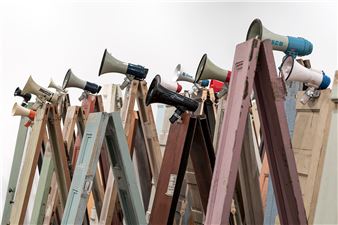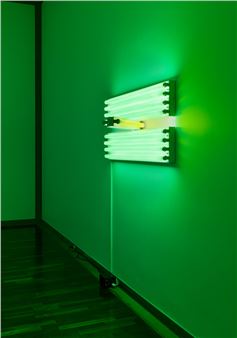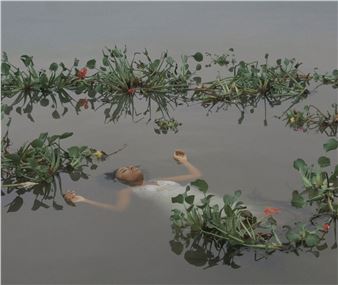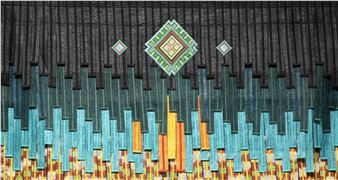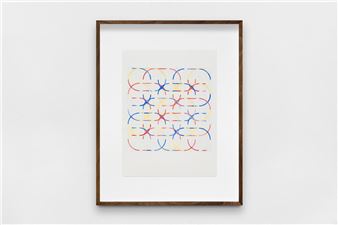Tarik Kiswanson: The Relief
Through sculptures and videos, Tarik Kiswanson explores themes of memory, trauma, and regeneration. How do the dark moments of our collective history inform the present? What can they teach us about the human condition? How do we endure trauma, and how do we possibly rebuild? These questions are central to Tarik Kiswanson’s practice and his exhibition "The Relief" at the Institut Suédois, in which most of the works are newly produced and all are being shown in France for the first time.
Tarik Kiswanson is one of the most acclaimed artists of his generation on the international stage. His multidimensional practice spans sculptural installations made of found and shaped objects, videos, and sound works. In his exhibitions, he blurs the lines between the architecture and the artwork itself, disrupting our spatial perception. Kiswanson’s works depict transitional states—through the interweaving of forms, materials, and expressions anchored in specific places, he creates transformative spaces.
At the heart of the exhibition is the Steinway Victory Vertical (1944), an upright piano created by Steinway & Sons in New York to provide psychological relief to the soldiers during World War II. Parachuted to Allied troops throughout Europe and carried across borders, the piano embodies the belief that creation, too, can save humanity. In the exhibition, the piano floats above an oblong white sculpture resembling a cocoon or an egg—a motif that has become emblematic in Kiswanson’s work. The piano transcends its historical context to become a symbol of comfort and healing. The cocoon, in turn, a carrier of collective memory, evokes a sense of resilience and new possibilities.
In a video placed on the floor, students from the Saint-Denis Conservatory attempt to play Ode to Joy, which became the official anthem of the European Union in 1986. This was Beethoven’s last and most famous symphony, originally performed with a poem by Schiller celebrating unity, friendship, and peace. Their hesitant gestures, silences, and repetitions offer a powerful metaphor: Who is Europe? Who identifies with it, and who has the right to do so? Who shapes Europe’s future?
In the works titled Foresight, chairs of different provenance intersect, merging distinct narratives. The Reading Chair by Danish architect Finn Juhl is fused with a chair by Brazilian manufacturer Móveis Cimo, once used in the waiting areas of Brazil’s immigration offices. Both chairs were made from Rio rosewood in 1953, but in radically different locations and contexts. In Kiswanson’s work, these two geographical poles converge, allowing their specific histories to be simultaneously linked on both personal and collective levels.
Elsewhere in the exhibition, a 1945 chair made by George Nakashima—an architect who was interned in U.S. detention facilities in the Idaho desert during World War II because of his Japanese heritage—intertwines with a chair from the same year by Adolf Gustav Schneck, a German architect affiliated with the Nazi party. These sculptures speak to parallels and paradoxes, the clash between silence and violence, and historical ruptures whose repercussions reverberate globally.
Tarik Kiswanson engages in a material archaeology of memory, recovering and translating the language of objects as a means of approaching what has happened, including the unspeakable. He does not aim to reconcile the contradictions of our history but to make them visible. We are united by the human condition, shaped by loss, migration, exile, and reconstruction. Kiswanson’s works do not merely reflect trauma—they offer a passage through it. They become sites through which it is navigated. In this way, his art operates as a space of transformation—where remembrance becomes an active process and where art may be viewed as a means to encourage understanding, resistance and healing.
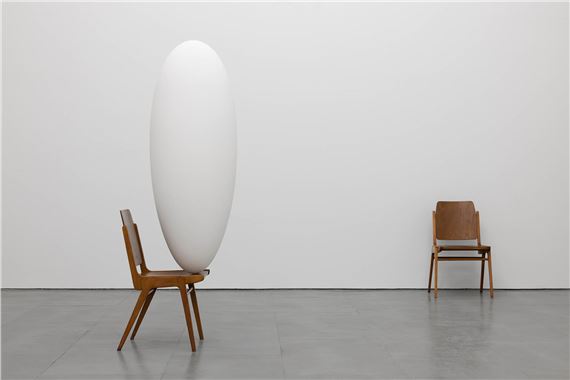
Recommended for you
Through sculptures and videos, Tarik Kiswanson explores themes of memory, trauma, and regeneration. How do the dark moments of our collective history inform the present? What can they teach us about the human condition? How do we endure trauma, and how do we possibly rebuild? These questions are central to Tarik Kiswanson’s practice and his exhibition "The Relief" at the Institut Suédois, in which most of the works are newly produced and all are being shown in France for the first time.
Tarik Kiswanson is one of the most acclaimed artists of his generation on the international stage. His multidimensional practice spans sculptural installations made of found and shaped objects, videos, and sound works. In his exhibitions, he blurs the lines between the architecture and the artwork itself, disrupting our spatial perception. Kiswanson’s works depict transitional states—through the interweaving of forms, materials, and expressions anchored in specific places, he creates transformative spaces.
At the heart of the exhibition is the Steinway Victory Vertical (1944), an upright piano created by Steinway & Sons in New York to provide psychological relief to the soldiers during World War II. Parachuted to Allied troops throughout Europe and carried across borders, the piano embodies the belief that creation, too, can save humanity. In the exhibition, the piano floats above an oblong white sculpture resembling a cocoon or an egg—a motif that has become emblematic in Kiswanson’s work. The piano transcends its historical context to become a symbol of comfort and healing. The cocoon, in turn, a carrier of collective memory, evokes a sense of resilience and new possibilities.
In a video placed on the floor, students from the Saint-Denis Conservatory attempt to play Ode to Joy, which became the official anthem of the European Union in 1986. This was Beethoven’s last and most famous symphony, originally performed with a poem by Schiller celebrating unity, friendship, and peace. Their hesitant gestures, silences, and repetitions offer a powerful metaphor: Who is Europe? Who identifies with it, and who has the right to do so? Who shapes Europe’s future?
In the works titled Foresight, chairs of different provenance intersect, merging distinct narratives. The Reading Chair by Danish architect Finn Juhl is fused with a chair by Brazilian manufacturer Móveis Cimo, once used in the waiting areas of Brazil’s immigration offices. Both chairs were made from Rio rosewood in 1953, but in radically different locations and contexts. In Kiswanson’s work, these two geographical poles converge, allowing their specific histories to be simultaneously linked on both personal and collective levels.
Elsewhere in the exhibition, a 1945 chair made by George Nakashima—an architect who was interned in U.S. detention facilities in the Idaho desert during World War II because of his Japanese heritage—intertwines with a chair from the same year by Adolf Gustav Schneck, a German architect affiliated with the Nazi party. These sculptures speak to parallels and paradoxes, the clash between silence and violence, and historical ruptures whose repercussions reverberate globally.
Tarik Kiswanson engages in a material archaeology of memory, recovering and translating the language of objects as a means of approaching what has happened, including the unspeakable. He does not aim to reconcile the contradictions of our history but to make them visible. We are united by the human condition, shaped by loss, migration, exile, and reconstruction. Kiswanson’s works do not merely reflect trauma—they offer a passage through it. They become sites through which it is navigated. In this way, his art operates as a space of transformation—where remembrance becomes an active process and where art may be viewed as a means to encourage understanding, resistance and healing.
Artists on show
Contact details

Related articles
Through sculptures and videos, Tarik Kiswanson explores themes of memory, trauma, and regeneration.
Paris Oomph is a curated roundup of the best contemporary art exhibitions and events held by galleries, museums, and institutions in town during Art Basel Paris, October 2025.
Through a complex and multidimensional body of work, Tarik Kiswanson explores notions of memory, trauma and regeneration.
Through a complex and multidimensional body of work, Tarik Kiswanson explores notions of memory, trauma and regeneration.

 ARTISTS
ARTISTS







